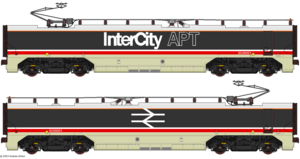British Rail Class 370
| British Rail Class 370 "Advanced Passenger Train" | |
|---|---|
| In service | 1980-1986 |
| Manufacturer | BREL |
| Family name | APT |
| Number built | 3 trainsets |
| Formation | 14 cars per trainset |
| Operator(s) | InterCity |
| Line(s) served | West Coast Main Line |
| Specifications | |
| Height | 3.5 m |
| Maximum speed | 155mph (249 km/h) (Design) 125mph (200 km/h) (service) |
| Weight | 434 t |
| Electric system(s) | 25 kV AC Overhead |


British Rail's Class 370 tilting trains, also referred to as APT-P (meaning Advanced Passenger Train Prototype), were the pre-production Advanced Passenger Train units. Unlike the earlier experimental gas-turbine APT-E unit, these units were powered by 25kV AC overhead electrification and were used on the West Coast Main Line between London Euston and Glasgow Central. The APT-P is the most powerful domestic train to have operated in Britain, the eight traction motors fitted to the two central Motor Cars giving a total output of 8,000 hp. This enabled the train to set the UK rail speed record of 162.2 mph in December 1979, a record that stood for 23 years.[1]
References[change | change source]
- ↑ "Train smashes speed record". 30 July 2003 – via news.bbc.co.uk.
